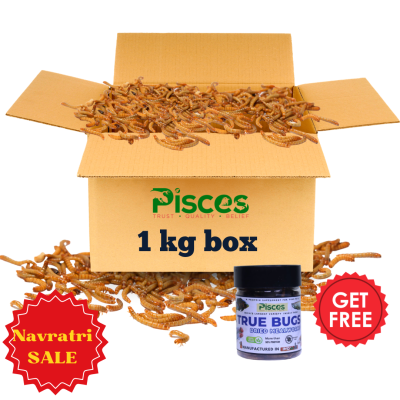Mealworms - True Bugs || Pisces The Farm- India's largest variety live feed farm.
How to pet a Sugar glider at home?

Sugar Glider Care Guide: Everything You Need to Know About These Adorable Marsupials
Sugargliders are interesting small marsupials and are one of the most popular exotic pets worldwide. These large-eyed creatures are nocturnal and possess gliding membranes. Sugar gliders are fascinating, cute companions for pet parents, and if you are thinking of bringing one home, this blog is all you need to know about them in detail.

Origin and Natural Habitat of Sugar Gliders
Sugar gliders (Petaurus breviceps) are native to a few countries, like Australia, New Guinea, and some parts of Indonesia. These very creatures are related to the same family of kangaroos and koalas and are called marsupials. Marsupials have one simple thing in common, which is their pouches where they keep their babies. In the wild, they inhabit eucalyptus forests and woodlands, gliding between trees using the membrane that stretches between their front and hind legs.

At first, these nocturnal creatures were spotted in the late 18th century, and over time, they have modified themselves to survive in sundry forest environments. Sugar gliders are social creatures and usually dwell in colonies consisting of 10 to 15 members, headed by a dominant male. Since their fondness for sweet foods, such as nectar and tree sap, their nomenclature has been so.
Originally discovered in the late 18th century, sugar gliders have adapted to various forest environments. They're social creatures that live in colonies of 10-15 members, led by a dominant male. Their name originates from their fondness for sweet foods, such as tree sap and nectar.
How to Pet and Handle Sugar Gliders at Home
Sugar gliders are delicate little creatures, so it is crucial to be gentle while holding them in your hands and while approaching them. Initially, bribe them with small treats, as this will create a sense of trust in the little creature and will make it feel safer. Another thing to keep in mind is to maintain a particular routine for playtime and feeding them.
Where to Purchase
Sugar gliders can be purchased from licensed exotic pet dealers and registered breeders, both online and offline.
Cost of Sugar Gliders in India
The price of sugar gliders in India generally ranges from ₹12,000 to ₹45,000, depending on their color variant, and they can be kept freely at home. A large flight cage is completely optional for keeping sugar gliders, and can cost around ₹15,000 - ₹20,000.
What to Feed Your Sugar Gliders
A balanced diet is essential for a Sugar glider, especially one that follows its natural food sources.
Foods that can be given : Superworms, mealworms, crickets, commercially available sugar glider pellets, different types of seeds, apples, grapes, berries, melons, potatoes, carrots, and corn.
Occasional treats : Cooked chicken, unsweetened yogurt, and a small amount of honey.
Foods to avoid: Avocado, onions, garlic, chocolates, dairy products (excluding a small amount of yogurt), and foods rich in oxalate content.

Identifying Health Problems in Sugar Gliders
Signs of illness in sugar gliders include depression, inactivity, loss of appetite or weight, watery eyes, lack of energy, red and scaly skin, sores, abnormal droppings, and excessive shedding or bald patches.
Emergency Warning Signs:
- Tremors or seizures (may indicate low calcium or blood sugar)
- Decreased appetite, lethargy, sneezing, or nasal discharge
- Self-mutilation behaviors
- Difficulty breathing or labored breathing
Common Health Issues:
- Malnutrition leading to calcium deficiency and metabolic bone disease
- Dental problems from high-sugar diets cause tartar buildup
- Parasites like mites
- Stress-related conditions
When to See a Veterinarian: Contact an exotic animal veterinarian immediately if you notice any unusual behavior, eating changes, or physical symptoms. Regular health checkups are essential for early detection of problems.

Conclusion
Sugar gliders can make rewarding pets for dedicated owners who understand their complex needs. However, their care requires significant time, financial commitments, and expertise. Before considering a sugar glider as a pet, thoroughly research local laws, find a qualified exotic veterinarian, and ensure you can provide the specialized care these unique marsupials require.
Remember that sugar gliders are social animals that do best in pairs, live 12-15 years, and require consistent daily care. With proper preparation and commitment, these fascinating creatures can become beloved family members.






